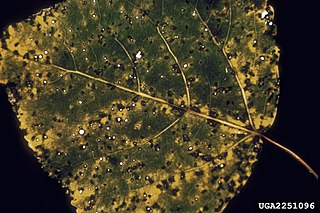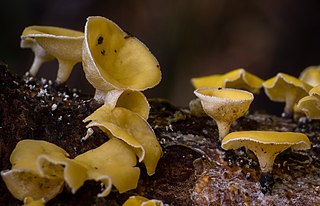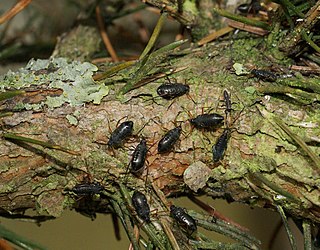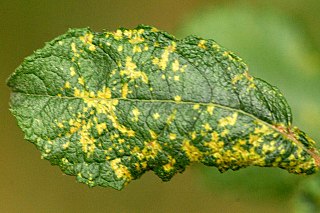
Rusts are fungal plant pathogens of the order Pucciniales causing plant fungal diseases.

Salix viminalis, the basket willow, common osier or osier, is a species of willow native to Europe, Western Asia, and the Himalayas.

Cladosporium is a genus of fungi including some of the most common indoor and outdoor molds. Some species are endophytes or plant pathogens, while others parasitize fungi.

Salix udensis is a species of willow native to northeastern Asia, in eastern Siberia, northeastern China, and northern Japan.
Uromyces euphorbiae is a fungal species and a plant pathogen infecting poinsettias.

Melampsora medusae is a fungal pathogen, causing a disease of woody plants. The infected trees' leaves turn yellowish-orange. The disease affects mostly conifers, e.g. the Douglas-fir, western larch, tamarack, ponderosa, and lodgepole pine trees, but also some broadleaves, e.g. trembling aspen and poplars. Coniferous hosts are affected in late spring through early August, and trembling aspens and poplars from early summer to late fall. It is one of only two foliage rusts that occur naturally in British Columbia.

Uromyces is a genus of rust fungi in the family Pucciniaceae. The genus was described by Franz Unger in his 1833 work Die Exantheme der Pflanzen. They have a worldwide distribution but large occurrences happen in North America and Europe.

Pleospora is a genus of ascomycete fungi. This genus was originally described by Gottlob Ludwig Rabenhorst in 1857 and was revised by Wehmeyer and Müller. There was an estimated 63 species in 2008. As of 8 August 2023, the GBIF lists up to 440 species, while Species Fungorum lists about 375 species.
Gonioglyptus is an extinct genus of trematosaurian temnospondyl within the family Trematosauridae. It is known from the Early Triassic Panchet Formation of India. It contains two species: G. longirostris and G. fragilis. The species G. kokeni from Pakistan has since been reclassified into Aphaneramma.
Drepanopeziza is a genus of fungi in the family Dermateaceae. The genus contains 14 species.
Otthia is a genus of fungi in the family Botryosphaeriaceae. There are about 76 species.

Lachnellula is a genus of fungi in the family Lachnaceae. The genus contains 40 species. Lachnellula was circumscribed in 1884 by Petter Karsten, with Lachnellula chrysophthalma assigned as the type species.
In the 10th edition of Systema Naturae, Carl Linnaeus classified the arthropods, including insects, arachnids and crustaceans, among his class "Insecta". Insects with membranous wings, including bees, wasps and ants were brought together under the name Hymenoptera.

Aecidium is a genus of rust fungi in the order Pucciniales.

Chrysomyxa is a genus of rust fungi in the family Coleosporiaceae. The genus, widespread in the Northern Hemisphere, contains about 23 species. Rust fungi in the genus Chrysomyxa occur in boreal forests of the northern hemisphere on Pinaceae,, and most species alternate to angiosperm hosts in the Ericaceae.

Cinara, the conifer aphids or giant conifer aphids, is a genus of aphids in the family Aphididae. They are widespread in the Northern Hemisphere.
Chrysomyxa abietis, or spruce needle rust, is a species of rust fungi in the Coleosporiaceae family that is native to eastern Europe and northern Asia. It was introduced to Australia, New Zealand and the United States.

Marssonina is a genus of fungi in the family Dermateaceae.

Melampsora caprearum is a fungal pathogen which causes galls on willows. Also known as a rust fungus, it was first described by Felix von Thümen in 1879.
Melampsora amygdalinae is a fungal pathogen and part of the division Basidiomycota. It is known as a rust fungus that is host specific. M. amygdalinae commonly infects willows of the genus Salix. This fungus was first discovered in 1909 by Heinrich Klebahn who was a professor of soil biology in Hamburg. Neimi at el. explain how the pathogen occurs throughout the whole distribution of the host, and the small natural populations are an area of interest. This rust fungus is annual and autoecious, which references the fungus spending its entire life in a single host.













